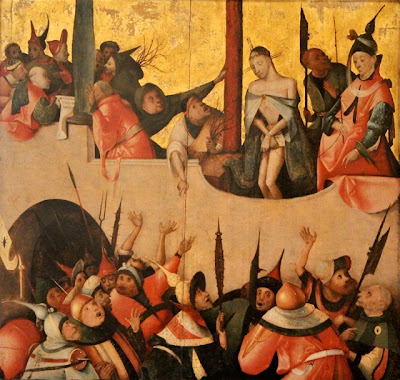By the time we awoke this morning, there was no denying that Dan had a cold; a bad cough sapped his energy all day. Even though the Philadelphia Museum of Art is near our motel, he decided we should take a taxi so that he didn't have to deal with the car. The weather was gray and damp.
The Philadelphia Art Museum is a big time art museum. What that means in practical terms is that it is overwhelming; there is way more to see than we could cover in the one day we allowed in our itinerary. We had been there twice before, so we thought we could just skim the highlights this time. We dashed about separately with our cameras, trying to find our old favorites, watching for changes and additions to the collection.
The museum has some of the most important paintings in art history. It is pretty hard to top van Gogh's Sunflowers.
 |
| Sunflowers, 1888-89 by Vincent van Gogh (Dutch, 1853-1890) Dan's photo |
.jpg) |
| The Large Bathers, 1884-87 by Pierre-Auguste Renoir (French, 1841-1919) Dan's photo |
 |
| The Large Bathers, 1906 by Paul Cézanne (French, 1839-1906) Dan's photo |
 |
| Nude Descending a Staircase (No.2), 1912 by Marcel Duchamp (American, born France, 1887-1968) Dan's photo |
Duchamp was scornful of traditional art forms; his favorite thing was to shock the art community, not to mention the general public. He was the first to adopt existing objects like bicycle wheels and urinals as "found" works of art.
 |
| A group of sculptures by Marcel Duchamp Jan's photo |
 |
| The Bride Stripped Bare by Her Bachelors, Even by Marcel Duchamp, 1887-1968 |
Pablo Picasso was working at the same time as Duchamp and in a similar spirit of turning convention upside down. The museum has his cubist depiction of three musicians playing jazz. This is one of the few subjects that Picasso portrayed twice in a similar manner; the other version is at the Museum of Modern Art in New York.
+1881-1973).jpg) |
| Three Musicians, 1921 by Pablo Picasso (Spanish, 1881-1973) Dan's photo |
Born in 1887, the same year as Duchamp, Marc Chagall is often associated with floating fantasies of romance or depictions of Russian folk ways, but I'm especially fond of his painting of a poet after a long night's quest for inspiration.
 |
| Half-Past Three (The Poet), 1911 by Marc Chagall (French, born Russia, 1887-1985) Jan's photo |
 |
| Little Painting with Yellow (Improvisation), 1914 by Vasily Kandinsky (French, born Russia, 1866-1944) Dan's photo |
 |
| Under the Pines, Evening, 1888 by Claude Monet (French, 1840-1926) Jan's photo |
 |
| The Battle of the U.S.S. Kearsarge and the C.S.S. Alabama, 1864 by Édouard Manet (French, 1832-1883) Dan's photo |
 |
| Le Bon Bock, 1873 by Édouard Manet (French, 1832-1883) Dan's photo |
 |
| Pont Neuf, Paris: Afternoon Sunshine, 1901 by Camille Pissarro (French, 1830-1903) Jan's photo |
 |
| Two Girls, c. 1892 by Pierre-Auguste Renoir (French, 1841-1919) Dan's photo |
 |
| The Ballet Class, 1880 by Edgar Degas (French, 1834-1917) Dan's photo |
To be considered a really important museum, a good collection of European Old Masters is required; PMA has got the goods.
 |
| The Mocking of Christ, Early 16th century Attributed to Hieronymus Bosch (Netherlandish, fd. 1474-1516) Dan's photo |
 |
| Francis I, King of France, c. 1532-33 by Joos van Cleve (Netherlandish, fd. 1511-1540/41) Dan's photo |
.jpg) |
| The Annunciation, 1650 by Francisco de Zurbarán (Spanish, 1588-1664) Dan's photo |
 |
| Madame Du Barry, 1781 by Louise Vigée-Lebrun (French, 1755-1842) Dan's photo |
As befits an American museum, PMA also has a collection of important American paintings.
 |
| Portrait of Mr. and Mrs. Thomas Mifflin (Sarah Morris), 1773 by John Singleton Copley (American, 1738-1815) Dan's photo |
 |
| Noah's Ark, 1846 by Edward Hicks (American, 1780-1849) Dan's photo |
 |
| Platte River, Nebraska, 1863 by Albert Bierstadt (American, born Germany, 1830-1902) Dan's photo |
 |
| A Huntsman and Dogs, 1891 by Winslow Homer (American, 1836-1910) Dan's photo |
 |
| Between Rounds, 1898-99 by Thomas Eakins (American, 1844-1916) Dan's photo |
.jpg) |
| The White Way, c.1926 By John Sloan (1871-1951) Dan's photo |
In the middle of the 20th century, abstraction was all the rage in America.
 |
| Painting with Two Balls, 1960 by Jasper Johns (American, born 1930) Dan's photo |
 |
| Untitled, c. 1960 by Joan Mitchell (American, 1925-1992) Dan's photo |
Though richly satisfying, the day was long and tiring, especially for Dan because of his cold. The museum building is huge and it has a confusing layout, that requires a lot of stair-climbing and retracing of steps. We had a nice lunch break at Granite Hill, "the museum’s pinnacle eatery." We both had fancy hamburgers with ultra-thin and crispy French fries.
When the museum guards shooed us out prior to closing, we easily snagged a cab for the return ride. When we got in, Dan went straight to bed, and he was out for the night. I napped for awhile. Then I went out and got some new cold medicine at a nearby store, which I administered to Dan when I returned. It suppressed his cough so he could sleep.
After dark, when I was about to return to sleep mode, I noticed a strange phenomenon: a large array of searchlights was playing about the sky, creating patterns of beams. I tried to photograph the sight, but the windows were streaked by a light rain. I wondered what the source or reason for the searchlights might be.
No comments:
Post a Comment